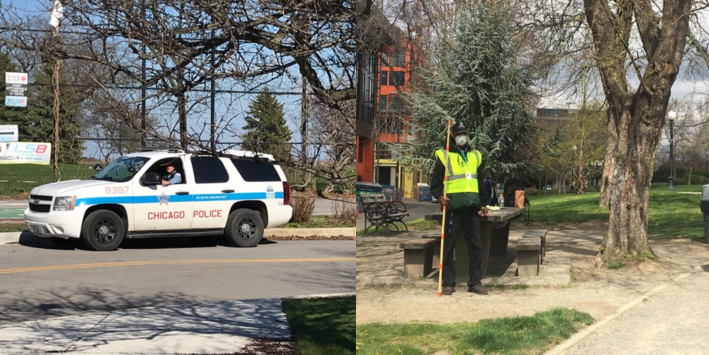This past weekend hundreds of thousands of Chicagoans ventured outside their homes to enjoy the warmer weather. It makes sense that people want to get out and enjoy sunlight and fresh air, even during a global pandemic.
Illinois' Stay at Home order acknowledges that "walking, hiking, running, or biking" are "essential activities," key for maintaining physical and mental wellness during this stressful time. Many experts agree that socially-distanced outdoor physical activity is beneficial during COVID-19.
For example, U. of C. psychologist Marc Berman argued in a recent interview that spending time outside is crucial for your health, even during the pandemic. "People are so cooped up inside, getting the mental break outside is going to be important.” And a new University of Virginia study found evidence that regular exercise may prevent coronavirus patients from developing severe complications like acute respiratory distress syndrome.
On March 26 Mayor Lori Lightfoot closed the entire shoreline, including the Lakefront Trail, as well as the Chicago Riverwalk and The 606 elevated greenway, in response to social distancing violations on the first warm day of spring. Other parks have been temporarily or permanently closed since then. Last weekend some elected officials were critical of the many people they saw using the parks, paths, and sidewalks, arguing that they were being irresponsible.

But the problem isn't people going outside to enjoy a walk or sunbathing in the park. Rather, I perceive two issues at play. One is the shortage of parkland, public space, and room for pedestrians, due to so much space in our city being used for moving and storing cars. The other is the over-policing of Black and Brown bodies in public space.
I reached out to Juanita Irizarry, executive director of Friends of the Park, get her point of view on creating more space for people during COVID-19.
Currently many Chicago police officers are parked at the lakefront 24-7 to enforce the shoreline ban. But Seattle has taken a different approach, hiring Social Distancing Ambassadors and deploying them in parks to educate and remind residents about safety rules, such as not congregating in large groups.

I was encouraged to hear Irizarry say that FOTP “can certainly get on board with a park ambassador program of some kind.” Social Distancing Ambassadors could encourage people to use the parks in ways that are consistent with public health guidelines.
Using civilians instead of police to promote compliance would reduce the possibility of encounters with citizens escalating into violence. It would also free up officers to spend more time addressing the current problem of dangerous speeding during the pandemic. Speeding is up 14 percent at the moment due to lighter traffic, according to the Chicago Department of Transportation, and the severity of crashes has increased.
Irizarry said FOTP has received complaints of police informing residents that park are closed when they're actually still open. She said the advocacy group has been in communication with the Chicago Park District about this problem. Unfortunately the issue persists despite the park district stating they have attempted to clarify park closure orders with the police.
Irizarry said FOTP wishes Lightfoot's initial decision to close the lakefront had taken more nuances into consideration. For example, the South Side portion of the Lakefront Trail sees less use than the North Side segment. (Accordingly, fewer police seem to be stationed on the south lakefront during the pandemic than on the north lakefront.)
“This is a good time for us all to examine and consider potential long-term policy responses to the underlying racial and economic inequities that have been laid bare during this pandemic," Irizarry said. "Thus far, we see the need for a ‘both/and’ approach.” She said this strategy should include:
- Better investment in park infrastructure and park programming in ways that are centered on the provision of appropriate programming versus revenue generation for the park district. (FOTP is gearing up to offer free programming such as walking for wellness and other fitness activities.)
- Adequate park space that is responsive to normal and emergency conditions. Irizarry pointed out that high density neighborhoods also need more parkland. As reported in FOTP's 2018 Chicago's State of the Parks report, the group found that Chicago needs more acres of parkland per person.
- Necessary changes to upcoming mega-developments like Lincoln Yards and The 78 which include narrow pathways that would not provide space for sufficient social distancing. Due to demand in Lincoln Park and neighborhoods further north, Irizarry said, “future open spaces need to be able to function as spaces for those transporting themselves and spaces where people can aimlessly stroll, play a game of frisbee, enjoy sunlight and nature, or some other appropriate activity for the purposes of leisure and mental health. A resilient, healthy Chicago cannot be subject to the whims and prejudices of private [developers] as we deal potentially for years with COVID-19 ramifications and adjusted lifestyles while also anticipating future threats.”
I am inspired by former New York City transportation commissioner Janette Sadik-Khan’s words regarding cities after COVID-19, “The challenge we face isn’t whether cities will survive. The question is whether we have the imagination and vision to transform streets to bring about the safer, more accessible, and more resilient cities we’ve needed all along.”







